Hackaday
4w
348

Image Credit: Hackaday
Relativity Space Changes Course on Path to Orbit
- Relativity Space initially aimed to be the first to send a 3D printed rocket into orbit, with plans to print an entire rocket using huge printers for faster and cheaper production.
- By March 2023, their first rocket, Terran 1, with 85% of its mass being 3D printed parts, was set for launch.
- Despite Terran 1 not reaching orbit due to a second-stage engine issue, Relativity Space proved the viability of 3D printed rockets.
- After a leadership reshuffle, with former Google chief Eric Schmidt taking over as CEO, the focus shifted away from 3D printing for the new Terran R rocket.
- Terran R's design now involves outsourcing critical components like tank domes and COPVs to established aerospace companies for faster development.
- Although Relativity Space had aimed to 3D print the tank domes, production speed limitations led to outsourcing this aspect.
- They continue to prioritize 3D printing the Aeon R engines for rapid design improvements and cost-effective production.
- The company's strategy now aligns with industry norms by using additive manufacturing when beneficial and opting for traditional methods when more efficient.
- Relativity Space's revised approach aims for timely launch readiness to compete with established commercial providers, prioritizing efficiency and strategic collaborations.
- Partnering with outside firms for critical components, the company is pushing towards a balance of additive and traditional manufacturing methods for efficient rocket development.
Read Full Article
20 Likes
For uninterrupted reading, download the app